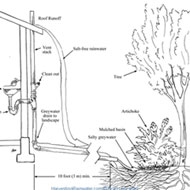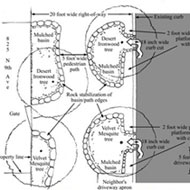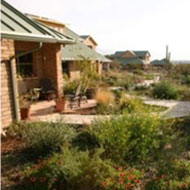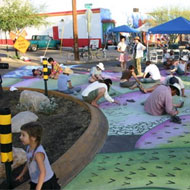Background
Tucson is located in the Sonoran Desert where it receives an average of 12 inches of rainwater per year. The City’s effort to promote water conservation and efficient use of water resources have resulted in Tucson’s average per capita residential water consumption being generally less than 112 gallons per day. That’s far below average rates in other parts of Arizona and in the western United States (City of Tucson).
Graywater can be a good source of irrigation water. In 2007, the state provided a tax credit of up to $1,000 for homeowners who install graywater systems (Feldman 2011). In 2008, Mayor and Council voted to require all new residences to be built with graywater capabilities. Beginning in June 2010, all new single family homes and duplexes were required to include plumbing for future graywater distribution. The city also provides manuals and guidelines to educate the public and to help install graywater facilities.
Brad Lancaster, a founder of the Desert Harvester, creatively found a way of harvesting rainwater—by cutting out a part of a curb and creating a water-catching basin around native plants. When he and his brother bought a house in the neighborhood in the 1990s, there were no trees or vegetation gardens. This also caused runoff on the street when it rained. With the neighbors’ and the city’s participation, now the street is filled with vegetation and large shade trees.
A water-catching basin, which can store street runoff and water street trees, is an effective way to conserve water. In addition, curb cutting allows more street runoff to be harvested in the basins or sidewalk strip. This is also a way to prevent storm water runoff pollution into waterways. In the desert area like Tucson, if a proper basin is provided, native plants, such as, Mesquite, Acacia, and Ironwood trees, can grow and produce edible flowers and seeds without additional watering.
Ideally, the diameter of the basin should be 1.5 to 3 times wider than the diameter of the mature canopy of the tree planted within it, because the roots uptake the majority of the harvested moisture beyond the drip line of their canopy. If there is not enough room to make a wide basin, a small basin or a number of small basins spread out around the plant is recommended. A building roof is a great source of additional runoff that can be harvested within the basin.
Increasing the number of rain gardens is another way to conserve water. In the Dunbar/Spring neighborhood, the residents petitioned the City of Tucson to build a traffic circle to slow down vehicles and capture more rainwater. Now there are several traffic circles in the neighborhood, which become a common space through special care of the community. In particular, there are traffic circles at every intersection on 9th Avenue in the Dunbar/Spring neighborhood between Speedway Boulevard and 6th Street. Each traffic circle is taken care of by the residents living at the corner, growing various edible plants with street runoff. Sometimes traffic circles also become a social gathering place. At University Boulevard and 9th Avenue, a community event was held to create an intersection mural.
Adopted from: Desert Harvesters
Lessons Learned
Potential Benefits:
- Conserves water by reusing street runoff as a source of irrigation water.
- Prevents storm water runoff pollution into waterways.
- Saves money on water bills for households.
- Grows native plants without additional watering when a proper water-catching basin is installed.
- Provides a better access to food for residents in the desert area by enabling them to grow edible plants.
Potential Issues:
- Neighborhood buy-in: Community participation is important to maintain the plants on the street.
- City support: Cutting curb and installing traffic circles require the city’s permission. Regulations should also be provided to encourage the planting of native species.
- Food-producing plants: Graywater surface irrigatation or street runoff should not be used to irrigate any plants that produce food, except for citrus and nut trees.
- Detergent use: When graywater is used for plant irrigation, care must be taken with detergent use (e.g., low sodium, no boron, no chlorine, low alkalinity).
- Basins: Basins should be installed before planting trees and should be an appropriate size and depth.
- Sensitive plants: Graywater should not be used on plants that are salt sensitive or need acidic soils.
Sources
Desert Harvesters, “Water Harvesting” (http://www.desertharvesters.org/water-harvesting/)
Feldman, Amy, 2011. “In Tucson, Saving the Bath Water Too,” Time. (http://www.time.com/time/specials/packages/article/0,28804,2026474_2026675_2055576,00.html)
City of Tucson, “Using Gray Water” (http://cms3.tucsonaz.gov/water/greywater)
Photo Sources
MIG, Inc.




